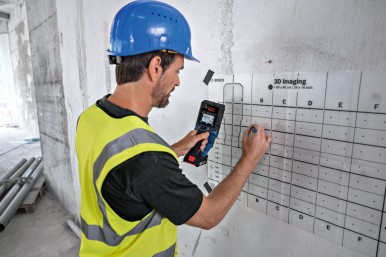Bosch connected agriculture highlights at Agritechnica:
Cloud-Services: Bosch connected solutions support farmers in their everyday work and help optimize harvests or make operating processes more efficient. The connected agriculture platform acts as a basis for developing a wide range of solutions, such as connecting machinery or using sensors to monitor fields. As a result, farmers can keep a constant eye on all relevant information – from the office or from the road. The software platform includes a comprehensive service module that allows Bosch to support manufacturers of agricultural vehicles and devices in developing all kinds of services and rapidly launching them.
Smart spraying: The new smart spraying technology, which Bosch is developing as part of a research partnership with Bayer, makes it possible to use herbicides only where they are really needed. Using camera sensors, the new technology is able to differentiate between crops and weeds, and uses special application technology to target weeds with pesticides. Weeds are precisely identified and pesticide is sprayed in a single process as the crop sprayer crosses the field. Multiple cameras spread across the entire width of the crop sprayer take a continuous series of pictures, identifying the different weeds and allowing the optimum treatment to be defined. While the crop sprayer is still crossing the field, the herbicide is sprayed in the required quantity and mixture using the appropriate application parameters. While the relevant weeds are targeted, weedless areas remain untouched.
Field monitoring: Frost and extreme heat can damage plants and promote diseases. At worst, growers could face crop losses, endangering their existence. The Bosch Deepfield Connect field monitoring system measures temperature and the humidity of the air and soil. From the field, data is transmitted to the Bosch IoT Cloud, and from there to the grower’s smartphone. Using an app, growers are able to see at a glance how their strawberries, potatoes, or asparagus are doing – without having to be in the field. If the soil is too dry, or if temperatures exceed a defined limit, growers are alerted. Conversely, if frost appears likely, they also receive a message and can cover their plants in good time. The values are stored in the app. The record of temperature and humidity readings helps farmers aerate and irrigate their crops properly, thereby increasing yields.
Milk monitoring: The Bosch Deepfield Connect milk monitoring system measures the temperature of milk using a sensor in the tank and transmits the values via the Bosch IoT Cloud to the smartphone of the dairy farmer, who is alerted if milk storage problems occur. Germs can form if the temperature of milk climbs above 4 degrees Celsius for a prolonged period of time, making milk go sour and negatively impacting farmers’ yields. To avoid this, the system monitors the milk tank’s refrigeration, cleaning, and agitator. Farmers can use the app to keep an eye on all the milk tank’s important functions, allowing them to act in good time before the milk becomes unfit for consumption. The values can be shared with dairies or tanker drivers, speeding up communication and making the processes between farmers and buyers more efficient. Unlike built-in temperature measurement systems in milk tanks, the Bosch system can be flexibly installed in any milk tank and retrofitted at any time.
Smart Cab: Smart Cab, which Bosch co-developed as a member of the CAB concept cluster, turns agricultural vehicles into connected command centers in the field. All components – vehicles, cameras, and drones alike – can interact with each other in the Smart Cab. Via the cloud, camera drones send detailed pictures of the condition of crops to the driver’s cab. Operators can also receive warnings from the object recognition camera about living obstacles such as deer. Using a feature store, manufacturers and vehicle users can upload their own smart farming functions, which can then be downloaded over the air directly to the machine.
Other Bosch innovations at Agritechnica:
Electronically controlled wiper direct drive: The new Bosch direct drive for windshield wipers is considerably smaller than conventional wiper drives with links. Each arm is powered by a drive of its own and mounted directly onto the motor shaft. The electronic control system synchronizes both of the drive units. Sensors integrated into the wiper drive detect the actual position of the wiper arms. This allows safe operation – even with reverse-rotation systems covering large wiping areas. The highly sensitive drive motor can recognize the amount of rain falling onto the windshield and then adjust the wiping cycle appropriately. And if there is a large accumulation of snow, the motor automatically reduces the wiping area and thereby protects the drive against overloads. The new direct-drive units are of identical construction for any vehicle window. Settings such as the wiping angle or the parking position are individually programmed by means of software once the assembly is finished. This simplifies logistics and storage for manufacturers of off-highway vehicles and agricultural-machinery workshops.
Electrical energy management: Agricultural-vehicle batteries have to withstand long seasonal idle times, yet they are expected to provide high starting power and have enough resources for supplementary equipment such as an air-conditioning system. Bosch therefore offers a comprehensive range of maintenance-free and extremely reliable batteries especially for off-highway vehicles. Moreover, Bosch’s new electrical energy management system ensures an intelligent load distribution and controls the increasing number of electric consumers. The main component is the EBS electronic battery sensor, which is installed in the battery terminal bay. Extremely precisely and dynamically, it measures the following battery values: current, voltage, and temperature. The EBS-integrated software analyzing the battery charge level determines the current and the projected battery condition. As a consequence, the charging process can be optimized, preventing deep discharge. The system can be adjusted to the different requirements of different vehicles, allowing flexible use in all kinds of vehicles. In addition, the BCM body computer module, the central comfort control unit, controls the increasing number of electric consumers and additional functions. Despite having its origin in large-scale production, it is flexible in terms of usage and can easily be adjusted to the specific requirements of the vehicle. The advantages are cost reduction through custom configuration, optimized cable harnesses, and shorter development times.
Modular common-rail system: The sophisticated common-rail system for commercial vehicles helps meet current and future requirements for on- and off-highway operation. Although the modular system is designed for engines of between four and eight cylinders, it can be used in the off-highway segment in engines of up to 12 cylinders. The system is suitable for 4 to 17 liters of engine displacement and power of up to 635 kW in the on-highway segment and 850 kW in off-highway. System components and modules can be put together in different combinations to meet the engine manufacturer’s specific requirements. That includes fuel- and oil-lubricated pumps (CP4, CP4N, CPN6c, CP6N), injectors (CRIN) for various installation situations, as well as rails and electronic control units of the new MD1 generation optimized in a networked system. Since various pressure levels between 1,800 and 2,500 bar are possible, manufacturers can fulfill the requirements of a wide range of segments and markets to the greatest possible extent. Depending on the demands it is subject to, the system can last for up to 1.6 million kilometers in on-highway operation, or 15,000 hours off-highway. Very high injector flow rates make it possible to optimize the combustion strategy and achieve high engine performance.
e-load sensing: e-load sensing (e-LS) makes comprehensive management of tractors and various attachments possible. It also supports new functions for automated, monitored workflows and simplified operation. Tractor manufacturers can therefore reduce their development and installation work by transferring previously hydromechanical functions to the software. Electronification opens up additional opportunities for increasing the availability of tractors through innovative services.
Smart services: As part of the electronification of mobile hydraulics, Bosch Rexroth is developing new, data-based services for all aspects of mobile working machines. Bosch Rexroth’s PredictDrivetrain service uses operating and sensor data to detect wear, and is able to determine the remaining service life. Downtimes for tractors, combine harvesters, and other agricultural and forestry machinery can therefore be avoided without the conventional, pre-scheduled preventive maintenance intervals. The lean determination of operating data also serves as a basis for the application-oriented design of mechanical components using the NextGenSpec app without the danger of undersizing or oversizing. For the assembly of new vehicles, CalibrateHydraulics significantly reduces the commissioning effort with the online transfer of test bench data for components to the OEM.
Controllers and sensors with SENT interface: The controllers for mobile working machines combine proven features, such as free programmability with a new hardware architecture and a future-proof software concept. Developed to meet more demanding system requirements, Bosch Rexroth is also developing sensors with a SENT interface that transmit condition data to the controller in addition to all measured values. The first controllers and the SENT sensors will go into regular production as early as 2018.
Hydrostatic travel drives: Harvesters, field sprayers, combines: Bosch Rexroth’s new hydrostatic travel drive solutions are reducing diesel consumption. In addition, the company is combining more efficient components with new, electronified system approaches and software packages. The ever-increasing electronification of travel drives also forms the basis for assistance systems that provide relief to the driver and increase the safety of the vehicles.
A10V(S)O medium pressure pump: By integrating an additional compression volume, Bosch Rexroth has cut the pressure pulsation of mobile hydraulic systems in the Rexroth A10 medium pressure pumps by half. The new solution reduces the noise emissions of agricultural and forestry machinery and improves the controllability of hydraulically operated vehicle functions.
SBx4, SM12-EHR12, and ROS12 (OC) valve platforms: With three hydraulic valve platforms, Bosch Rexroth covers the current and future requirements for mobile hydraulics in tractors across the whole performance range from 40 kW to 400 kW. The new Rexroth SBx4 platform meets the requirements of the premium class. Rexroth SM12-EHR12 supports the mid- and low-range power segments, while the ROS12 (OC) valve platform was specially developed by Bosch Rexroth for the Asian market. Bosch Rexroth also offers the corresponding valves for electrohydraulic hitch control for all versions.
EHC-8 electrohydraulic hitch control: With its EHC-8 electrohydraulic hitch control, Rexroth has developed a system solution that meets the needs of emerging markets with tractors from 30 kW upward. It efficiently improves soil cultivation as the basis for higher crop yields and also increases driver safety. The components are adapted to the climatic conditions of tropical and subtropical regions such as India, Southeast Asia, Africa, and South America.





